The best athletes in the world all start at the beginning. To be good, great or the best, there are no shortcuts. Regardless of your goal—to be the world’s best or to start training with a new tool as a way to introduce something fresh to your program—the key is to start with the basics. That means learning and mastering the basics skills before focusing on how much, how long or how fast.
In an ACE-sponsored study, researchers from the University of Wisconsin-La Crosse concluded that, in addition to the predicted strength gains, kettlebell training improved core strength and dynamic balance, and increased aerobic capacity. With such a diverse increase in specific exercise markers, it’s no wonder kettlebell training continues to grow in popularity.
Regardless of where you want to be in three, six or 18 months, using kettlebells can be a great way to help you reach your goals. Like most training tools, using the correct technique is critical. Take the time to perfect your technique before progressing to the more advanced moves. Many of the advanced movements in kettlebells build on the basics swings and catches. As you become more proficient, the basics moves can become part of your warm-up routine to prepare you for the more complex movements. Don’t let the need to use a heavy starting weight get in the way of your technique. If your goal is to use the heaviest kettlebell out there, don’t worry—it’s waiting for you. Perfect your technique first. Remember—practice makes permanent, and perfect practice makes perfection.
This program should be completed after running through a warm-up, paying particular attention to ensuring the glutes, hips, torso and shoulders are warm. Rather than focusing on reps, a different approach is to complete a few reps, stop, rest and repeat. As you become more comfortable, add a few more reps. Set yourself a time range in which you want to work. It is more important to complete the reps while using good form than it is to check the box for a certain number of reps. When starting out, take 20 to 30 seconds to complete a set and then rest for 30 seconds. Spend no more than five minutes on each exercise.
Kettlebell Deadlifts
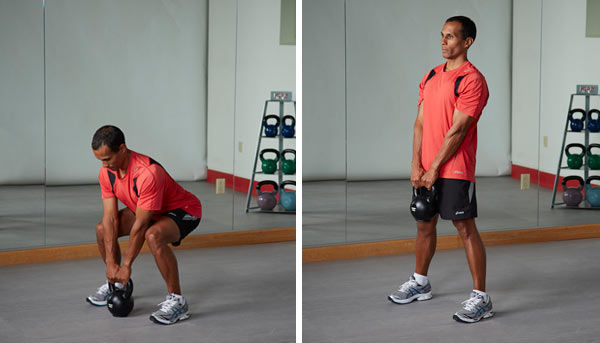
This is a great exercise to start warming up the body.
Set up: Stand with the feet shoulder-width apart, toes slightly out. Keep the chest up and the back straight. Bend at the hip and slightly at the knees to lower and grip a kettlebell with both hands.
Follow up: While keeping the weight on your heels, drive the hips open to a standing position. Brace the core and squeeze the glutes.
Kettlebell Two-arm Swing
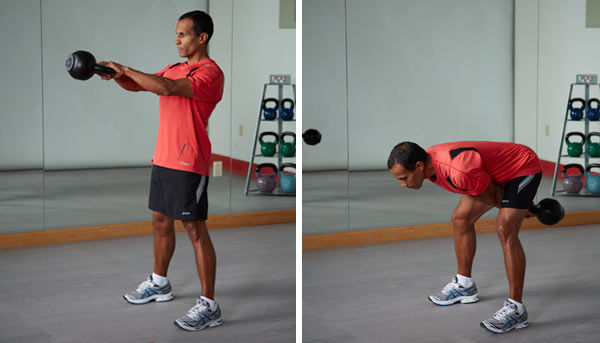
This exercise is a foundational movement. Once you master this exercise, you can proficiently move to other movements such as the single-arm swing, snatches and cleans.
Set up: Start with a kettlebell on the floor, centered in front of your feet. Assume a deadlift position. Grasp the kettlebell and extend and hike/pull the kettlebell up and back through your legs. As the kettlebell reaches the end of its arc, use an explosive sharp movement and extend your knees and hips.
Follow up: Contract the glutes as you extend the hips, and keep the biceps close to the rib cage. The kettlebell should travel up to approximately mid chest height.
Kettle Single-arm Swing
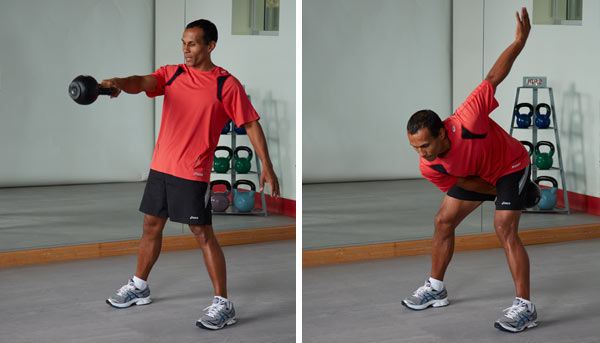
This movement starts to challenge the core because you not only need to control the kettlebell as it swings through its arc, but the rotation as well.
Set up: Start with a kettlebell on the floor, centered in front of your feet. Assume a deadlift position. Grasp the kettlebell with one hand and extend and hike/pull the kettlebell up and back through your legs. As the kettlebell reaches the end of its arc, use an explosive sharp movement and extend your knees and hips. The kettlebell should travel up to approximately mid chest height. (Tip: Turn the thumb of the hand holding the kettlebell toward the glutes as you swing back and then twist (supinate the forearm) toward the front as you swing the kettlebell forwards.) Complete the desired number of repetitions and then switch sides.
Follow up: Keep the grip arm straight and strong through the arc.
Goblet Squat
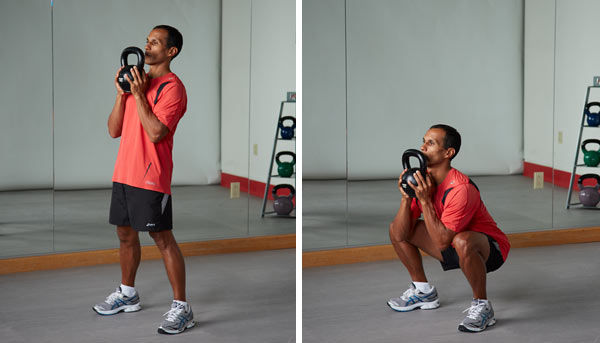
This exercise is just one of a few different ways to perform a squat using kettlebells.
Set up: Hold a kettlebell with both hands at chest height. Stand with the feet shoulder-width apart, toes slightly out; keep the chest up and back straight.
Follow up: Bend at the hips and knees and push the hips back. Keep the elbows forward as you sit back down into a squat. Keep the weight on the heels as you drive the hips back up to a standing position.
Lunge
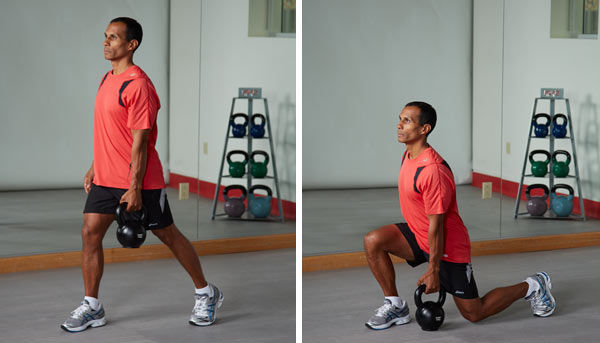
This exercise can be also performed with a kettlebell in both hands or with a single kettlebell extended over the head.
Set up: Stand comfortably and hold a kettlebell in the right hand. Step forward into a lunge with the left foot.
Follow up: While keeping the chest lifted and the shoulders pressed back, push through the forward leg back to the standing position. Complete the desired number of repetitions on one leg and then switch sides.




 by
by 
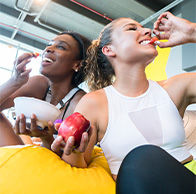




 by
by